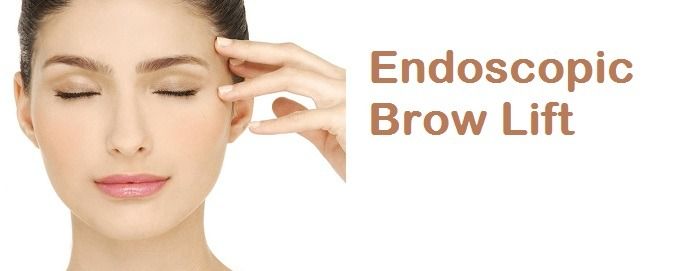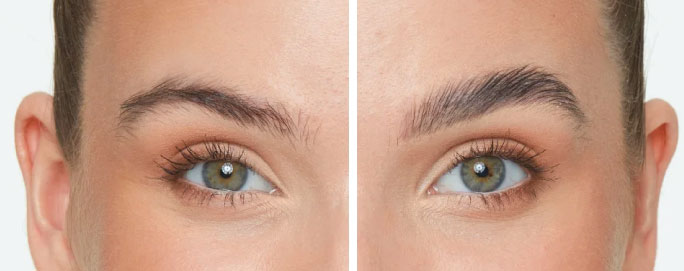Skip to a Particular Section
Brow Lift in Houston Texas

The forehead lift and brows represent the upper one-third of the face and with the aging process, the brows descend. This causes a “hooding” over the upper eyelids and transverse wrinkling of the forehead. In the midline of the forehead over the root of the nose, between the eyebrows are the vertical glabellar frown lines. They appear as vertical lines resembling the number “eleven” or even a number “one hundred eleven.” The underlying corrugator muscles cause these lines to form as they contract over time. In the past, a long incision extending from ear to ear over the top of the head, then peeling down the entire forehead, was necessary to elevate the brows. Wound healing, numbness, and hair loss were significant with this procedure. Today, I prefer the endoscopic method for Brow Lift in Houston Texas. Through three, one-inch vertical incisions in the hairline, an endoscope is passed. It is the same device gynecologists, orthopedists, and general surgeons use and with the help of the endoscope, the forehead tissue is freed and pieces of the corrugator muscles are removed. The forehead is elevated and attached to the new position with an endocrine device. The endocrine device is made from absorbable suture material. Thus, the body heals in the new elevated position, and then the endocrine dissolves, disappears, and goes away. This leaves an elevated brow without transverse wrinkles or glabellar frown lines. All performed through several small incisions, which heal quickly with minimal downtime, making this an ideal approach for a Brow Lift in Houston Texas.
What is an Endoscopic Forehead / Brow Lift?
The endoscopic brow lift is a procedure that restores a more youthful, refreshed look to the area above the eyes. The procedure corrects drooping brows and improves the horizontal lines and furrows that can make a person appear angry, sad or tired.
The tissues that cause furrowing or drooping of the brow are removed or altered to smooth the forehead, raise the eyebrows and minimize frown lines. Dr. Peterson uses of an endoscope, a viewing instrument that allows the procedure to be performed with minimal incisions.
What is Endoscopy?
Endoscopy is a surgical technique that involves the use of an endoscope, a special viewing instrument that allows a surgeon to see images of the body’s internal structures through very small incisions.
What is an Endoscope?
An endoscope consists of two basic parts: A tubular probe fitted with a tiny camera and bright light, which is inserted through a small incision; and a viewing screen, which magnifies the transmitted images of the body’s internal structures. During surgery, the surgeon watches the screen while moving the tube of the endoscope through the surgical area.
It’s important to understand that the endoscope functions as a viewing device only. To perform the surgery, a separate surgical instrument–such as a scalpel, scissors, or forceps–must be inserted through a different point of entry and manipulated within the tissue.
Botox Brow Lift
Discover an active new you with Brow Lift Botox – the hassle-free procedure to a fresh and natural charm. This creative procedure, using specific botulinum toxin injections, artfully raises and purifies eyebrows, bidding goodbye to any bowing problems. Adopt your renewed self without the objection of vast recovery or surgery. The process is quick, almost painless, assuring you can ideally come back into your routine. It’s not only about smoothing crumples; it’s a journey to a lifted brow and a naturally glowing face. Get ready to easily show confidence and fit accurate beauty with the transformative touch of Brow Lift Botox.

Brow Lift Before And After
- Before Brow Lift: In the “before” phase of a brow lift, people commonly experience issues such as sagging eyebrows and deep forehead ruffles. The eyebrows may appear lower than expected, presenting a tired or aged look.
- After Brow Lift: Experience an exceptional transformation as lifted eyebrows open up the eyes and decrease forehead ruffles. The result is a refreshed, youthful look that enhances overall facial aesthetics.
Nyx Lift And Snatch Brow Pen
The Nyx Lift and Snatch Brow Pen is an exceptional procedure in brow products. With its specific pen applicator, this eyebrow pen allows easy and maintained application, helping define and sculpt brows easily. While Botox brow lift takes it a step further, offering a non-invasive solution to lift and reshape eyebrows.
Brow And Forehead Lift
A brow and forehead lift is a transformative cosmetic procedure that renews the upper face. By this process eyebrows are elevated, reducing wrinkles and creating a refreshed look. Consulting with a skilled practitioner like Dr. Robert Peterson, MD, Plastic Surgery practices ensures a personalized approach.
Endoscopic Brow Lift Procedure
The endoscopic forehead lift: Typically, an endoscopic forehead lift requires the same preparation steps as the traditional procedure: the hair is tied back and trimmed behind the hairline where the incisions will be made.
Rather than making one long incision as in a traditional brow lift, Dr. Peterson will make three, four or five short scalp incisions, each less than an inch in length. An endoscope, which is a pencil-like camera device connected to a television monitor, is inserted through one of the incisions, allowing the surgeon to have a clear view of the muscles and tissues beneath the skin.
Using another instrument inserted through a different incision, the forehead skin is lifted and the muscles and underlying tissues are removed or altered to produce a smoother appearance. The eyebrows may also be lifted and secured into their higher position by sutures beneath the skin’s surface or by temporary fixation screws placed behind the hairline.
After Endoscopic Brow Lift
Endoscopic brow lift patients may experience some numbness, incision discomfort and mild swelling. Incision site pain is usually minimal, but can be controlled with medication, if necessary. Endoscopic forehead lift patients usually experience less of the itching sensation felt by patients who have had the classic forehead lift.
The stitches or staples used to close the incisions are usually removed within a week and the temporary fixation screws within two weeks.When the lift is complete, the scalp incisions will be closed with stitches or clips and the area will be washed. Gauze and an elastic bandage may also be used.

